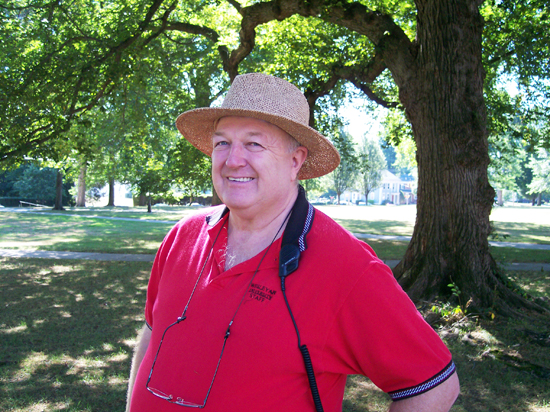Grounds and Special Events Manager Knows the Landscape
 |
| Dave Hall, grounds and special events manger, stands in front of an old elm tree planted along College Row. Wesleyan once had hundreds of elms on its property, and now only a few remain. The rest have fallen prey to old age or disease. |
| Posted 09/09/05 |
| When Dave Hall takes a daily stroll across Wesleyans campus, he has no destination in mind. He simply enjoys the luscious landscape. It is, after all, his masterpiece.
As manager of Wesleyans grounds and events, every tree, shrub, flower garden and grassy knoll is part of his canvas. Most people walk through campus looking straight ahead or at the ground, Hall says, gazing into an elm. Theres a whole new world to see if you look up. Theres lots of interesting trees to see here on campus. Hall has memorized where virtually every tree stands on campus. He knows their species, in many cases their age and even their quirks. As he walks through campus he points out some of his favorites. The 1826-built Russell House property hosts Wesleyans oldest trees four cut-leaf European beeches. Hall suspects these were planted inside the iron fence just after the Russell House was built. Another campus oldie grows in front of the Davison Arts Center. Recognized by its gray, elephant-skin-like trunk, this beech is more than 150 years old. And then theres the pink-blossomed cherry tree atop Foss Hill. I couldnt even guess as to how old that cherry is, Hall says. But it sure is gorgeous in early spring when it turns into a pink cloud. The Presidents patio possesses the second largest Japanese zelkova tree known in Connecticut. The states third largest is down the street in front of Alpha Delta Psi. Hall says a giant sycamore, located between the Center for the Arts North and South Studios, is one of Wesleyans most striking trees. Its spotted bark makes it a prime study for students art projects. You should see this tree in the winter, Hall says. When theres snow on the ground and the tree is all barren except for its branches, it brings ideas of suspense and horror stories. The campus landscape has changed drastically over Wesleyans 175 year history. In a 1830s photograph, Hall points out a row of elms lining a sidewalk to North College. Today only one remains. Dutch Elm disease was the main culprit. Those elms used to be all over, Hall says. There were probably hundreds of them here in the 1800s, and now there are only 20 left on campus. Wesleyans formerly abundant hemlocks have also been destroyed by a human-imported nemesis known as the wooly adelgids. And then there was the huge oak tree on Church street. It was a sad, sad day when we had to take down that old oak between Shanklin and the library, Hall says, noting that it had rotted from inside-out. But when one tree goes, another is planted — or transplanted — if possible. In the early 80s, a series of five-year-old pear trees were removed from the Judd Hall area and transplanted in front of College Row on High Street. Hall calls these white-blossoming trees the soldiers. Theyre lined up in formation. He also helped plant the mature red oaks on College Row in the early 1980s. You know that youve been here a long time when you see trees grow from seedlings to full size, he says, grinning. Nancy Albert, university coordinator of events and Russell House Programs, admires Hall for nurturing the rose arbor behind the Russell House. She also counts on his advice when planning outdoor events. Dave knows what lies beneath the ground, so stakes do not accidentally sever phone or computer lines, and he has an uncanny memory about what was done over the past years, she says. Plus his weather instinct is the best. If he says its going to rain, follow his advice. Hall, who grew up in Lincoln, Maine never took any agriculture or landscape classes. Hired into Wesleyan as an equipment operator, Hall self-taught himself grounds management. Now he oversees Wesleyan contractors Stonehedge Landscaping, which handles many of the universitys grounds crew needs. Hall says no two days are alike. Some days hell oversee sidewalk repairs, remove fallen branches, or plant shrubs. Recently, he helped set up the football stadium. In the winter, he oversees snow removal. Hes constantly responding to calls from Public Safety, Physical Plant or other departments needing grounds service. I like how nothing is monotonous, and the things that I do here make a difference and I can feel good about that, Hall says. Whether it be removing a low branch as a safety issue, or planting a new shrub that makes campus look more beautiful, the things that I do to make campus better can be very fulfilling. |
| By Olivia Drake, The Wesleyan Connection editor |

